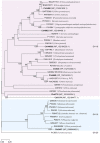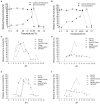Genomic analysis and chitinase characterization of Vibrio harveyi WXL538: insight into its adaptation to the marine environment
- PMID: 37465025
- PMCID: PMC10350509
- DOI: 10.3389/fmicb.2023.1121720
Genomic analysis and chitinase characterization of Vibrio harveyi WXL538: insight into its adaptation to the marine environment
Abstract
Chitin, the most abundant bio-polymer in seawater, may be utilized by various microorganisms as a carbon source. Vibrios have been regarded as one of the main groups of chitin consumers in the marine carbon cycle and chitinase producers. The organisms are widely distributed in the aquatic environment. However, the co-working mechanism between their chitinases, and whether the chitinase's diversity contributes to their adaption to the environment, needs to be further elucidated. Here, we obtained a chitinolytic strain, Vibrio harveyi WXL538 with eight putative chitinase-coding genes. Five of the genes, i.e., Chi4733, Chi540, Chi4668, Chi5174, and Chi4963, were overexpressed and validated, in which Chi4668, Chi4733 and Chi540 were purified and characterized. The result of Chi4668 was described in our previous study. Endo-chitinase Chi4733 degraded colloidal chitin to produce (GlcNAc)2 and minor (GlcNAc)3. The enzymatic activity of Chi4733 was 175.5 U mg-1 and Kcat/Km was 54.9 s-1 M-1. Chi4733 had its maximum activity at 50°C and pH 4-6, activated by Sr2+, Co2+, Ca2+, and Mg2+ and inhibited by Al3+, Zn2+, Cu2+, Ni2+, and SDS. Exo-chitinase Chi540 degraded colloidal chitin to (GlcNAc)2. The enzymatic activity of Chi540 was 134.5 U mg-1 and Kcat/Km was 54.9 s-1 M-1. Chi540 had its maximum activity at 60°C and pH 6-8, was activated by Sr2+, Ca2+, and Mg2+ but inhibited by K+, Ba2+, Zn2+, Cu2+, Ni2+, SDS and urea. Whole genome analysis of V. harveyi WXL538 and characterization of its chitinase can provide a better understanding of its adaptability to the changing marine environment.
Keywords: Vibrio harveyi; adaptation; chitinase characterization; genome analysis; marine environment.
Copyright © 2023 Ran, Wang, He, Guo, Wu, Zhang and Zhang.
Conflict of interest statement
The authors declare that the research was conducted in the absence of any commercial or financial relationships that could be construed as a potential conflict of interest.
Figures






Similar articles
-
Two Highly Similar Chitinases from Marine Vibrio Species have Different Enzymatic Properties.Mar Drugs. 2020 Feb 27;18(3):139. doi: 10.3390/md18030139. Mar Drugs. 2020. PMID: 32120805 Free PMC article.
-
Functional metagenomics reveals differential chitin degradation and utilization features across free-living and host-associated marine microbiomes.Microbiome. 2021 Feb 14;9(1):43. doi: 10.1186/s40168-020-00970-2. Microbiome. 2021. PMID: 33583433 Free PMC article.
-
Cloning, expression, and characterization of a chitinase gene from the Antarctic psychrotolerant bacterium Vibrio sp. strain Fi:7.Extremophiles. 2001 Apr;5(2):119-26. doi: 10.1007/s007920100179. Extremophiles. 2001. PMID: 11354455
-
Purification and characterization of chitinase from Paenibacillus sp. .Biotechnol Appl Biochem. 2021 Feb;68(1):30-40. doi: 10.1002/bab.1889. Epub 2020 Feb 19. Biotechnol Appl Biochem. 2021. PMID: 31957084 Review.
-
Bacterial Chitinase System as a Model of Chitin Biodegradation.Adv Exp Med Biol. 2019;1142:131-151. doi: 10.1007/978-981-13-7318-3_7. Adv Exp Med Biol. 2019. PMID: 31102245 Review.
Cited by
-
Description and Genome-Based Analysis of Vibrio chaetopteri sp. nov., a New Species of the Mediterranei Clade Isolated from a Marine Polychaete.Microorganisms. 2025 Mar 11;13(3):638. doi: 10.3390/microorganisms13030638. Microorganisms. 2025. PMID: 40142530 Free PMC article.
-
Genomic adaptations of Vibrio campbellii to thermal and salinity stress: insights into marine pathogen resilience in a changing ocean.BMC Genomics. 2025 Aug 8;26(1):736. doi: 10.1186/s12864-025-11908-z. BMC Genomics. 2025. PMID: 40781596 Free PMC article.
-
Chitin degradation by the aquatic pigment-producing bacteria of Janthinobacterium spp. from stream flows and springs of Shulgan River basin and Shulgan-Tash Cave, Southern Urals.Biodegradation. 2025 Jul 6;36(4):58. doi: 10.1007/s10532-025-10155-z. Biodegradation. 2025. PMID: 40618301
-
ChiVariARIBA: a modular, editable workflow and database for characterising chitin gene variation in Vibrio spp. and related bacteria.Microb Genom. 2025 Jul;11(7):001439. doi: 10.1099/mgen.0.001439. Microb Genom. 2025. PMID: 40679853 Free PMC article.
References
LinkOut - more resources
Full Text Sources
Molecular Biology Databases
Research Materials
Miscellaneous

